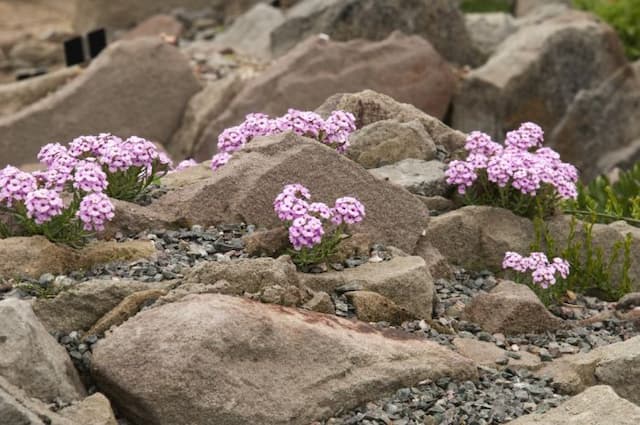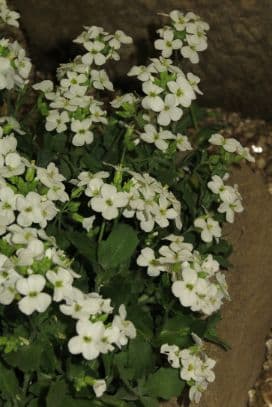Large cress Pachyphragma macrophyllum

ABOUT
Commonly known as large-flowered pachyphragma, this plant is a hardy perennial that is appreciated for its lush, decorative foliage and delicate floral displays. The leaves are heart-shaped with a rich green hue and a slightly toothed margin, forming a basal rosette that remains attractive throughout the growing season. In early spring, the plant sends up clusters of small white flowers, which bloom profusely in round, flat-topped clusters. The petals of each flower are creamy white and possess a simple, yet charming, beauty that is a herald of spring in the garden. The overall effect of the foliage and flowers together creates a pleasing groundcover or border plant that is enjoyed for both its aesthetic qualities and its ability to thrive in various conditions. The plant tends to have a bushy habit and can spread to form substantial clumps over time.
About this plant
 Names
NamesFamily
Brassicaceae.
Synonyms
Large Cress, Caucasian Pennywort.
Common names
Hesperis macrophylla, Isatis macrophylla, Pachyphragma nudicaule
 Toxicity
ToxicityTo humans
Pachyphragma macrophyllum, commonly known as large bittercress, is not widely documented as toxic to humans. There is little to no information readily available on the symptoms of poisoning as it is not commonly recognized as a poisonous or harmful plant when touched or ingested. Therefore, large bittercress is generally considered safe regarding human toxicity.
To pets
Large bittercress is also not widely documented as toxic to pets. There is limited information on its effects when ingested by animals such as dogs or cats, but it is generally not listed among plants that are known to be poisonous to pets. As with any non-food plant, ingestion might potentially cause mild stomach upset, but no severe toxicity symptoms have been widely reported.
 Characteristics
CharacteristicsLife cycle
Biennials
Foliage type
Deciduous
Color of leaves
Green
Flower color
White
Height
1-2 feet (30-60 cm)
Spread
1-2 feet (30-60 cm)
Plant type
Herb
Hardiness zones
5
Native area
Caucasus
Benefits
 General Benefits
General Benefits- Low Maintenance: Pachyphragma macrophyllum, also known as large-leaved pachyphragma, typically requires minimal care once established, making it suitable for gardeners with limited time.
- Shade Tolerance: This plant can thrive in partial to full shade, offering a solution for garden spaces that lack direct sunlight.
- Aesthetic Appeal: With its large green leaves and white springtime flowers, it can enhance the visual interest of garden beds and borders.
- Ground Cover: The plant can spread over time, providing a dense cover that can help suppress weeds and protect soil from erosion.
- Wildlife Support: The flowers of large-leaved pachyphragma can attract pollinators such as bees, supporting local biodiversity.
- Seasonal Interest: Pachyphragma macrophyllum provides early flowers, often in late winter or early spring, giving it a valuable role in seasonally planned gardens.
- Hardiness: It is hardy in a range of temperate climates, which means it can withstand cold temperatures and does not need extensive winter protection.
- Soil Versatility: This plant can accommodate a variety of soil types, though it prefers moist, well-drained soil.
 Medical Properties
Medical PropertiesThis plant is not used for medical purposes.
 Air-purifying Qualities
Air-purifying QualitiesThis plant is not specifically known for air purifying qualities.
 Other Uses
Other Uses- Pachyphragma macrophyllum, commonly known as large-leaf pachyphragma, can be used as ground cover in shady gardens due to its tolerant nature and attractive foliage.
- The plant's dense growth habit can suppress weeds, making it a natural, low-maintenance option for gardeners looking to reduce the number of unwanted plants in their beds.
- As a decorative component in terrariums, large-leaf pachyphragma adds a lush, green backdrop and can thrive in the humid, contained environment.
- Large-leaf pachyphragma can be used in floral arrangements, especially in early spring when its delicate white flowers can add a touch of elegance to bouquets.
- The plant can be used in the study of bee and butterfly behavior as its early spring blooms provide a nectar source when other plants have yet to flower.
- Gardeners can utilize large-leaf pachyphragma for erosion control on sloped areas, as its root system helps hold soil in place.
- In cooler climates, large-leaf pachyphragma leaves can be mulched to provide winter protection for more tender plants in the garden.
- Due to its ability to spread, large-leaf pachyphragma can be planted to fill in large, empty areas of a garden quickly, providing a uniform green cover.
- The plant's foliage can act as a living mulch, maintaining soil moisture and temperature, and reducing the need for additional mulching materials.
- Children and educators can use large-leaf pachyphragma in school science projects to demonstrate plant growth and development in temperate climates.
Interesting Facts
 Feng Shui
Feng ShuiThe plant Pachyphragma macrophyllum, commonly referred to as the large-leaved Pachyphragma, is not used in Feng Shui practice.
 Zodiac Sign Compitability
Zodiac Sign CompitabilityThe large-leaved Pachyphragma is not used in astrology practice.
 Plant Symbolism
Plant Symbolism- Modesty: Pachyphragma macrophyllum, commonly known as Large Bittercress, often grows in humble conditions and does not boast large, flashy flowers, which can symbolize a simple and unpretentious demeanor.
- Resilience: As a plant that can endure in a variety of environments, Large Bittercress is often associated with the ability to withstand difficult circumstances and recover from adversity.
- New Beginnings: The blooming phase of Large Bittercress is in the early spring, which can symbolize the start of new endeavors or the clean slate of the upcoming season.
 Water
WaterLarge Bittercress prefers consistently moist soil, so it's important to water it when the top inch of soil feels dry to the touch. This plant typically needs watering once every week, but this can vary depending on the environmental conditions. During the growing season in spring and summer, you might need to water it more frequently, such as every 3 to 5 days, to maintain the moisture level. Ensure you're providing enough water to moisten the soil throughout the pot, which could be approximately 16 to 32 ounces per watering, depending on the size of the pot and the plant. Always allow excess water to drain away to prevent waterlogging, which can lead to root rot.
 Light
LightLarge Bittercress thrives best in partial shade to full shade conditions. It should be placed in a location where it receives dappled sunlight or bright, indirect light. Avoid exposing the plant to direct afternoon sun, which can be too intense and may cause leaf scorch. A north-facing or east-facing window, if grown indoors, or a shaded spot under taller plants or trees, if grown outdoors, would be an ideal spot for this plant.
 Temperature
TemperatureLarge Bittercress prefers cooler temperatures and can survive in a range from about 50 to 75 degrees Fahrenheit. The ideal temperature range for promoting healthy growth is between 60 and 70 degrees Fahrenheit. While it can tolerate light frosts, prolonged exposure to temperatures below 50 degrees Fahrenheit can be harmful to the plant, and temperatures above 75 degrees Fahrenheit can stress the plant, especially if humidity is low.
 Pruning
PruningPruning Large Bittercress isn't typically necessary, but you may trim off any damaged or yellowing leaves as needed to maintain its appearance and health. If the plant becomes leggy or overgrown, it can be lightly pruned in early spring before new growth begins to encourage a bushier growth habit. Pruning is also an opportune time to remove any spent flowers or seed heads to prevent unwanted self-seeding.
 Cleaning
CleaningAs needed
 Soil
SoilThe ideal soil mix for large bittercress should be rich in organic matter, well-draining, and maintain a pH of around 6.0 to 7.5. A mixture of loamy garden soil, compost, and perlite or sand would provide the necessary nutrients and aeration.
 Repotting
RepottingLarge bittercress does not require frequent repotting and should be repotted every two to three years or when it outgrows its container.
 Humidity & Misting
Humidity & MistingLarge bittercress prefers moderate humidity levels, typically around 40-60%, which is within the range of average household humidity.
 Suitable locations
Suitable locationsIndoor
Place large bittercress in medium light and ensure soil is moist.
Outdoor
Grow in partial shade; keep in moist, well-drained soil.
Hardiness zone
4-8 USDA
 Life cycle
Life cyclePachyphragma macrophyllum, commonly known as Large-flowered Pachyphragma, begins its life as a seed which, when sown in fertile, moist soil and with the right temperature conditions, germinates and sprouts into a seedling. The seedling grows into a vegetative stage, characterized by the development of a basal rosette of heart-shaped leaves that are distinctive for the species. As the plant matures, it generates stems that bear white to pale pink flowers in early spring, typically in its second year of growth. After pollination, which is often facilitated by insects attracted to the flowers, the plant produces fruits in the form of capsules that release seeds once mature. These seeds spread, often by gravity or water, leading to the propagation of new plants, completing the life cycle. The Large-flowered Pachyphragma is a perennial plant, and after the flowering and seed-setting stages, it enters a period of dormancy during the colder months, only to re-emerge the next spring.
 Propogation
PropogationPropogation time
Spring to Summer
Pachyphragma macrophyllum, commonly known as Large-flowered Pachyphragma, can be propagated by seed. The best time to sow seeds is in the spring after the danger of frost has passed in your area. This typically aligns with outdoor temperatures reaching around 60 to 70 degrees Fahrenheit (16 to 21 degrees Celsius). To propagate by seed, scatter the seeds on the surface of a well-draining soil mix, and lightly press them into the soil without covering them, as they need light to germinate. Keep the soil moist but not waterlogged until germination occurs, which usually takes a couple of weeks. Seedlings can be transplanted into the garden once they are large enough to handle and after hardening off to acclimate them to outdoor conditions.



![Aubrieta [Axcent Light Blue]](/_next/image?url=https%3A%2F%2Fplants-admin.emdemapps.com%2Fimages%2Fplants%2F%2Fimages%2F604b5e7128866.png&w=640&q=75)





